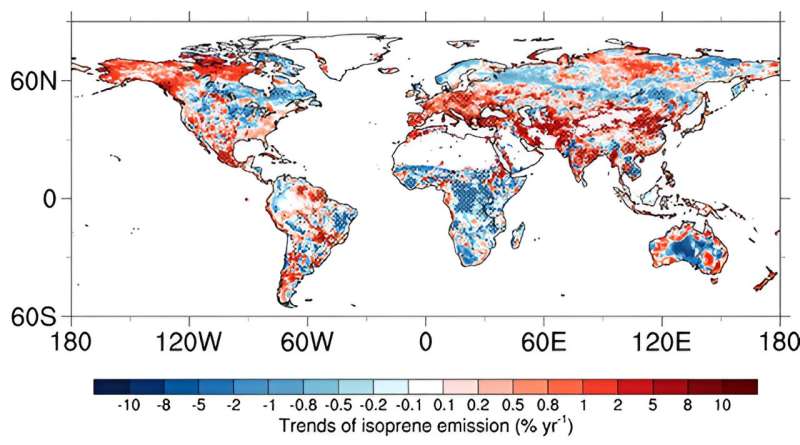This article has been reviewed according to Science X's editorial process and policies. Editors have highlighted the following attributes while ensuring the content's credibility:
fact-checked
peer-reviewed publication
trusted source
proofread
New study reveals influencers of global biogenic volatile organic compound emission trends over the last 20 years

Biogenic volatile organic compounds (BVOCs) emitted by vegetation are important precursors of ozone and secondary organic aerosols in the atmosphere, affecting air quality, clouds, and climate. However, BVOC emissions remain highly uncertain because they depend on a variety of factors, and the relative importance of different factors is still unclear.
In a study published in the journal Atmospheric Chemistry and Physics, a team of scientists from the Institute of Atmospheric Physics of the Chinese Academy of Sciences and Texas A&M University has simulated regional to global changes in BVOC emissions over the past two decades using the latest BVOC emission model, MEGANv3.2.
The researchers quantified the contributions of different drivers, such as vegetation, meteorological parameters, and carbon dioxide concentration, to BVOC emission trends, and they found that BVOC emission trends vary among different regions.
While global greening trends significantly boost BVOC emissions, deforestation, coupled with the rapid agricultural expansion, reduces BVOC emissions in South America and Southeast Asia.
In addition, elevated temperatures in Europe and increased soil moisture in East and South Asia contribute to the increase in BVOC emissions in these regions.
"This study improves our understanding of long-term BVOC emission trends at regional to global scales," said Prof. Liu Xiaohong, corresponding author of the study. "These findings also provide an important reference for the projection of future BVOC emission trends."
More information: Hao Wang et al, Regional to global distributions, trends, and drivers of biogenic volatile organic compound emission from 2001 to 2020, Atmospheric Chemistry and Physics (2024). DOI: 10.5194/acp-24-3309-2024
Journal information: Atmospheric Chemistry and Physics
Provided by Chinese Academy of Sciences




















